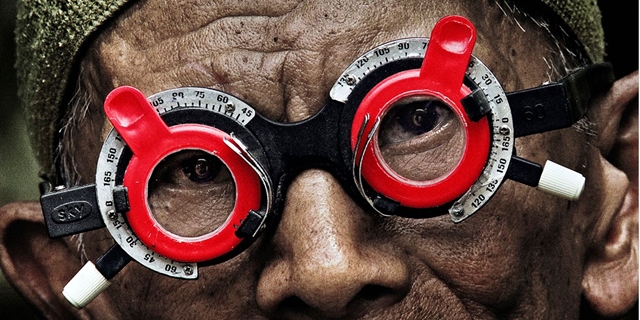
The Look of Silence (2014) Directed by Joshua Oppenheimer. IMDB says: “A family that survives the genocide in Indonesia confronts the men who killed their relative.”
Review by Steven
Danish filmmaker Joshua Oppenheimer’s Oscar nominated The Act of Killing, took an unusual route of recalling the horrors of the Indonesian genocide that took place in the mid-60’s. Death squad members, now old men, were asked to dress up and recreate some of the bloody atrocities they were responsible for. It was a bold approach that produced unusually cathartic results and the director continues to probe the subject in The Look of Silence, although this time in a more traditional manner.
In this accompanying follow-up, we see things from the victim’s perspective, through the eyes of Adi, whose brother Ramli was savagely murdered as part of the anti-communist cleansing that took place under military rule. Adi is a medical eye specialist and his job allows him the opportunity to come face-to-face with his brother’s killers and the more senior members of the regime. From the foot soldiers to the commanders and Governors, each one calmly confronted by a man whose family still struggle to cope with the loss of a son.
Fifty years on these mass murderers are now frail and old but seemingly no less repentant about their crimes. Many still hold literal and figurative power within their respective regions and so have never been brought to task for what took place. It is estimated one million men, women and children were killed by religiously motivated death-squads, who were fed propaganda by the military and used as murderous pawns to propagate larger political agendas. Like African slavery or the Jewish genocide, it isn’t really possible to comprehend the true meaning of such widespread carnage but by focusing on one story, it questions how we may approach such trauma.
Time and again, Adi is mostly met with defiant silences, marking a refusal by these men to revisit the past. Their guilt appears to have become deeply internalized, or five decades have warped their perception of what took place. The past is just the past, there is no use digging up old ghosts and causing trouble, is something we hear these old men repeat. But as we see through Adi’s own children, the deceit and rewriting of history is being taught in schools, shaping future generations, despite having lost relatives of their own.
Oppenheimer follows Adi as he questions these men, having to protect his true identity in case his probing leads to reprisals against his family. He sits down with a now senile mass murderer and his daughter, hearing how he would drink the blood of his victims to ‘give him power’. “It is sadistic” she says hearing of it for the first time and there is a painfully humane connection made between herself and Adi. Both represent an age group still struggling to come to terms with the level of inhumanity that occurred, still learning of new atrocities that affect both the victims and perpetrators families.
As you would expect the tone is thoughtful and somber throughout, allowing us plenty of time and room to absorb the journey and issues Adi is undertaking. The Look of Silence is the type of documentary that stays on your mind for days after, with a sobering subject matter that puts the trivialities of Western life into a certain perspective. Depressingly, as the credits begin to roll up the screen, the word ‘Anonymous’ begins to repeatedly appear, the names of the Indonesian crewmembers missing because of the fear that still exists around discussing this subject. We are always told that time heals all but that only occurs when you can confront the past and many Indonesians are yet to be afforded that basic human right.

OVERALL SCORE: 94%
The Look of Silence is now playing in select theaters nationwide.

